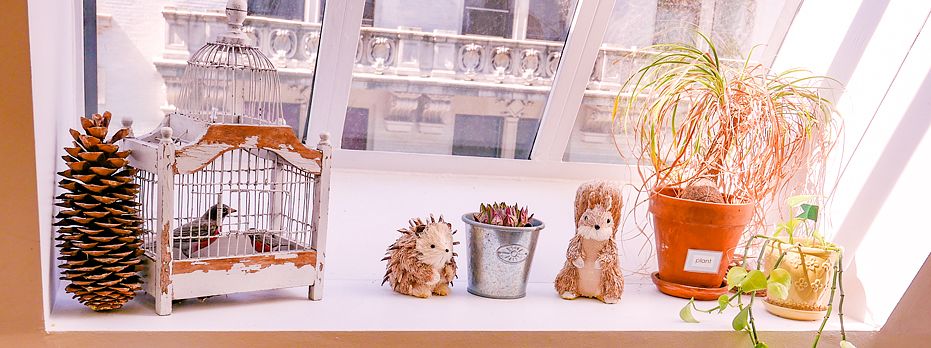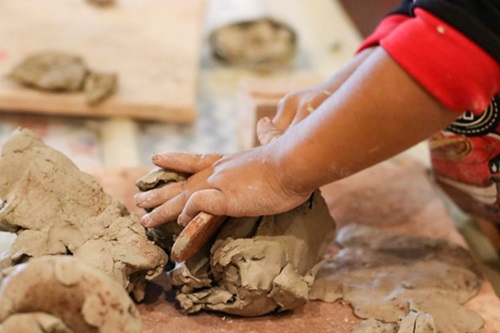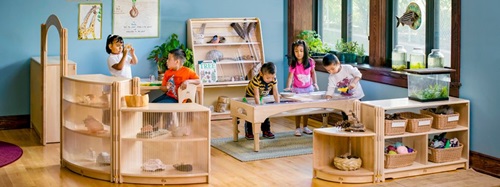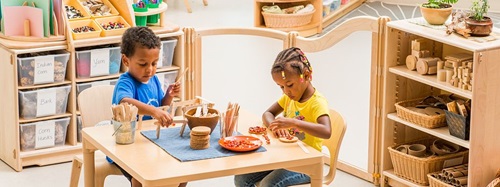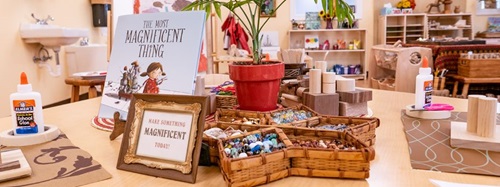How the Environment Inspires Curriculum
| March 2009Working in Reggio-inspired ways
Working with schools on transforming their practice or at least beginning on the path of Reggio-inspired practice has taught me many lessons. I have visited schools around the country and had reinforced time after time the idea that what we believe about children is visible in the choices we make within our schools. Nowhere is this more evident than in the environment. The choices about the environment we create also link directly to the play and learning in individual classrooms and schools. As part of the educational experience, we can render a great influence on the how and why of the actual play that is enacted, and curriculum engaged, by virtue of the choices we make in constructing these spaces. It is for these reasons that the environment is a wonderfully concrete place to begin asking educators to look at what they are communicating about how they view children.
What does environment as the third teacher mean?
It is important to begin by unpacking what is meant by the idea of the environment as the third teacher. This concept, brought into awareness through the schools of Reggio Emilia, connotes something that has always lived within early childhood—a particular care and attention to the settings in which children learn. The Reggianni have taken the examination and articulation of the environment to a new level.
This concept of the environment as a participant in the educational experience opens up the possibility for students to engage the environment with their peers and respond to thoughtful decisions made by the educators in an effort to support student engagement. This calls on the adults to render the environment a living space that actively participates in the educative process.
Our ideas about these lived spaces have evolved and been influenced in different ways by educators as varied as Maria Montessori, Lev Vygotsky, Vivian Paley and Loris Malaguzzi. Each of these educators has left their own influence: from child-sized furnishings, to the creation of social spaces for language development, and the importance of a stage for storytelling. These details, when woven together, have shown us both in theory and practice that schools for young children are spaces that attend to social interaction, problem solving, dramatic play, storytelling, fantasy, conflict and its resolution, and communication as a few of the vehicles for children to build their repertoire and further their understanding of the world. In order to achieve this balance of engagement, the environment is critical to offer opportunities to think, construct and create for children. So part of the work for us as educators is to strive to create a space that supports the interaction and engagement of the children with their environment on their own terms and at times without adult mediation. Essentially, the school puts at the disposition of the children the places and the materials, and the students make their new stories and worlds fueled by their imaginations.
Looking at the environment you have
Typically, I ask educators to create a map of the environment in which they work and discuss ways that their environment is working or is challenging. This offers teachers a wonderful platform to begin examining and dialoguing about their practice in collaboration with their colleagues. Teachers can also look at inventive ways to make minor changes in an attempt to align their environment more closely with this view of children. It is amazing how powerful simple changes can become in a cumulative fashion, made one at a time. For example, one of the most important steps I have seen schools make is de-cluttering their spaces, which can be full of unintentional knick-knacks. An armful of boxes and hefty bags in a quest to simplify surfaces and examine the intentionality of the choices made within an environment produced great results. Once the actual setting is uncovered, it is possible for the participating professionals to imagine, as children do, the possibilities that exist within the environment.
What is the purpose: Making changes
Recently, I was working with a school that had been in operation for many years. The teachers had taken great care to lay out the environment for my visit with audio recorders and headphones draped on the rug for use, as well as paints with brushes, multiple sized papers, a light table, etc. In this particular instance, the care of the presentation was noted, but despite this, it was difficult to overlook the clutter— overwhelming clutter, dust, and lack of purpose behind many of the articles included in the environment. It was like visiting my grandmother’s attic. What struck me, which happens for all of us as individuals, is that we sometimes stop seeing the environment in which we live. We have to look beyond the pile of recycling or old pillows.
One of the first things we did at this school was walk through the entire space, room by room, while I asked the staff to talk to each other about the purpose behind the choices that had been made. The question I found myself asking over and over was, “What is the purpose…(of this or that)?” If the response was a shoulder shrug or a blank look—then the teachers needed to talk to each other about what these choices communicated about the view of children alive in this environment; as well as the possibilities these choices eliminated for their students. Essentially, what was the thinking behind the couches, plants, storage of paints, materials to be thrown away, mirrors, light tables, everything. Clutter communicates something to children—just like eating off of paper plates or having wall hangings all at adult eye level—and what is implicitly communicated plays out in student engagement and behavior.
So, in looking at the space used to learn for your children, I encourage teachers to examine the following:
- What spaces have you created for your students?
- Are they clearly identifiable?
- Are they easily redefined to respond to student activity and interests?
- Are they provocative and suggestive without limiting engagement?
Children have imaginations that help them create and fuel their stories, but it is helpful if areas of the classroom are clearly organized. So house play and dress up can be together with the storage of these items, although the characters that emerge from their stories will roam the setting, furthering their experience in many parts of the classroom space. Another example might include the light table and the implements that may be used with it, or the construction area—it is important for children to know where things go, and that is where we can help them live in the space—but it is up to the children to create the stories within these spaces. So, while the blocks may have an area in the classroom, that is not to say that the birthday party that began in the house play area cannot migrate to play out within the construction section. We want to offer the children fluidity of definition and this takes a critical and attentive eye to the flushing out of the environment.
Next steps
It is important to look at your environment with fresh eyes and a questioning stance. It is in this way that you are able to keep a dynamic and lived space that continues to engage your students and offers multiple opportunities for problem solving with your children. It is with this in mind that you are asked to remain open to the possibilities inherent within a space and seek to open possibilities for your students, permitting them engagement in ways we as adults might not imagine.

